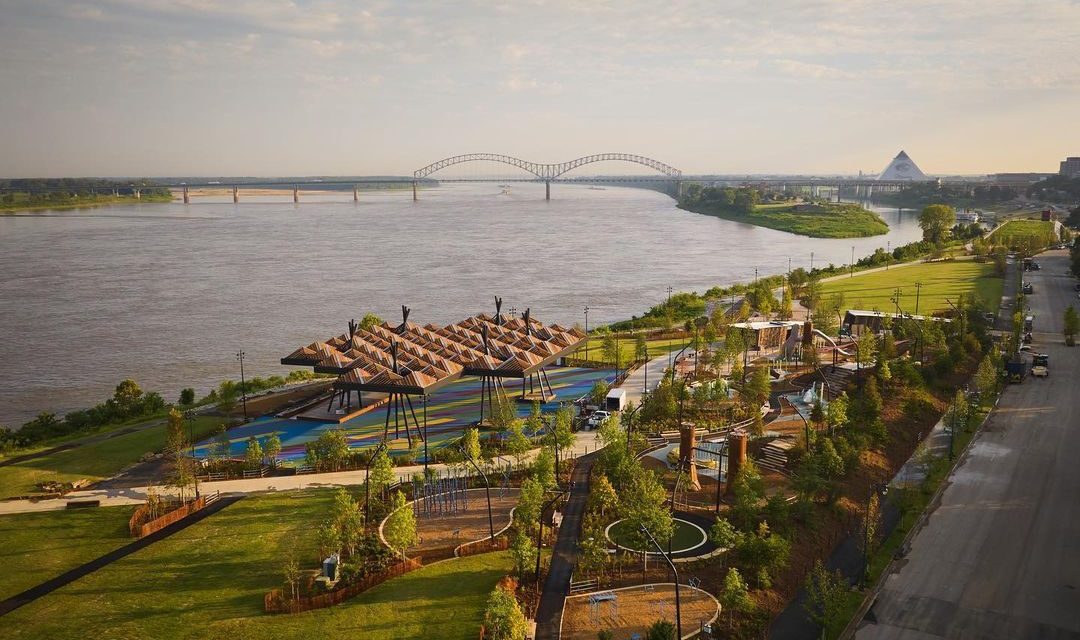It may have taken 100 years to create the riverfront Memphis deserves, but the administration of Mayor Paul Young is determined to leverage the current momentum.
That new passion for making the most of the reimagined six miles of riverfront parks was on display when the administration of Mayor Paul Young responded to Memphis City Council member Rhonda Logan’s request for a comprehensive plan for the riverfront’s future.
At the August 6 City Council parks committee meeting, the mayor’s chief operating officer Antonio Adams detailed the administration’s next steps and its priorities: 1) Enhance and connect assets to North and South Memphis, Downtown, 2) Activate the harbor and other key assets, and 3) Determine a successful and sustainable future for Mud Island.
It reflected the kind of response that is expected by an administration headed by a professional planner occupying the mayor’s office.
Memphians have long been frustrated by announcements for plans that were destined to be put on a shelf. In these instances, the document is treated as the outcome rather than implementation of the plan.
And while there was a multitude of riverfront studies and plans that largely met this fate since the 1980s, the commitment by the Young Administration was made clear. Mr. Adams said the new planning process will acknowledge and draw on prior studies for the current riverfront and build on it to consider how to get the full potential of the riverfront.
A Strong Foundation To Build On
Some new City Council members – and perhaps some old ones – seem to forget that they can see the results of a previous plan on the riverfront today. It was the 2017 “concept plan” developed by Studio Gang at the direction of the special City of Memphis riverfront task force. The concept plan articulated what the riverfront could be and led to City of Memphis designating the Memphis River Parks Partnership to implement it.
It was a mandate first laid out in Memphis’s first comprehensive plan by legendary urban planner Harland Bartholomew who write in 1924hat the riverfront was “not merely unattractive but represents a flagrantly unprofitable use of the property…that could be transformed into a picture of combined commercial and recreational activities truly representative of the city’s character and unsurpassed in attractiveness in any other city.”
Finally, today, because of the city government-inspired concept plan, his words have become reality and it was done in record time. Now there are six connected miles of trails connecting three new parks on the riverfront – River Garden, two acres of open space that sat empty and was named for the president of the Confederacy, became an award-winning eclectic public space; Fourth Bluff, once a graveyard for Confederate detritus and now welcoming to Memphis in all its diversity, as shown in Grizzlies watch parties; and Tom Lee Park, a spectacular 30-acre park with national and international recognition helping to rebrand Memphis and attracting a million visitors in its first year.
It all happened because there was a plan – a plan that was actually executed, a plan that heralded a new attitude to aim higher and think boldly, a plan that now becomes the foundation for a new comprehensive plan by a new planner-led city administration.
Please, No Magic Answers
There are times when it is clear that City Council members are part-time elected officials as some display amnesia about something explained in a previous meeting or perhaps more like Rip Van Winkle waking up in the midst of the dream of getting elected and grappling with the reality of governing.
Each Council member displays their own distinctive personality and behavior but hopefully, in supporting the comprehensive riverfront plan and its recommendations, they will join together to support the way ahead.
It is not likely to be easy. Council meetings are often the venue for members’ magic answers and favored solutions, especially when Mud Island is the subject, from Ferris wheels to zip lines to refurbishing the deteriorating amphitheater. That’s not even counting suggestions to level the site and develop it in commercial ways.
The challenge may well be giving each of these ideas analysis to determine their feasibility and their costs – specifically the cost to city government and potential private investment – their impact, and their ability to accelerate the rebranding of Memphis that the new riverfront has begun. There are other complex issues such as configuring the best street system that serves the goals of the new plan.
Besides the Studio Gang Concept, there are other resources to inform the plan for the future. There is a thoughtful review of Mud Island by national real estate and economic development experts HR&A Advisors, an assessment of the Mud Island amphitheater costs, and recommendations in Memphis 3.0 and Downtown Memphis Commission reports.
Rely On Expert Advice
The 11 riverfront parks have never looked as good as they do today. That’s why the most intriguing objective for the planning process is to look beyond the parks to broadly define the riverfront to include the bluffs and beyond and to strongly connect the riverfront to north and south Memphis and downtown.
Connectivity was a priority for Tom Lee Park’s reinvention and to build on that work now requires an all hands on deck approach with planners from the Division of Planning and Development and planners from Downtown Memphis Commission sharing their broad expertise in transportation, neighborhood growth, and urban planning as part of the riverfront process. The opportunity to better get the relationship between the riverfront and its surrounding areas right is crucial for Memphis to succeed.
For more than 100 years, Memphis turned its back on its riverfront and finally this is being corrected but the linkages and the mutual benefits are yet to be maximized. That is likely the most challenging priority for this planning process but it also has the greatest potential for positive impact.
As options are considered, city government will hopefully rely on expert advice as it sifts through the plethora of ideas and hire safety and structural experts as it evaluates Mud Island, including the amphitheater whose foundations raise serious questions about its safety for public use.
As Mr. Adams warned: “I caution us to make sure we are intentional. We have to develop with a purpose and stay with that purpose. If we just throw it out there and we spitball it (with this idea and that idea), then it becomes a wasted resource.”
On the surface, the three priorities stated by Mr. Adams seem straightforward but it will require a steady and trusted hand. He appears the right person for the job, going from interim COO to permanent COO status with the vote of the City Council at its last meeting.
An Impact COO
Mr. Adams represents a traditional type of City of Memphis CAO/COO. He has no ego need or engages in headline hunting. He is direct but politically astute in his comments in Council meetings. Most of all, he never forgets his name is not on the ballot and his loyalty is to the mayor and to his positions. When he speaks, there is no confusion that it is the mayor’s opinion.
In November, he will be employed by City of Memphis for 18 years, most of which were spent in the General Service Division which is responsible for all maintenance of several hundred city buildings, several thousand vehicles, and city support services. Before that, he handled City of Memphis discrimination claims and negotiation and administration of labor agreements.
In other words, he is a career employee and it gives him a unique context for approaching issues and problems without emotion and with the knowledge that whatever is the big issue today will not be the big issue next week. It’s why he has the patience and wisdom to sit without comment through orations like those by Council Member Yolanda Cooper-Sutton who is inclined toward personal attacks and ignores factual information from the administration while repeating conspiracies from sources with axes to grind.
As Mr. Adams, Memphis River Parks Partnership, and the City of Memphis Parks Division move forward in the development of a “roadmap,” he said with the voice of experience that this process will gather input from stakeholders, community partners, and the public but to do this, it is important to “kill noise on the line.” That allows the process to proceed methodically and without the trolling, conspiracies and personal, hostile assaults that are so often part of anything connected to the riverfront.
Sifting the meaningful input from the kneejerk snark will be part of the process, especially when it comes to Mud Island. The challenge there will be to find a successful and sustainable answer in a few months for a facility that has been called a failure for 35 years of its 42 years.
The Mud Island Conundrum
Mr. Adams’s general services background was evident when he spoke about the way Memphis builds projects but doesn’t plan for its maintenance and update costs for the future. It’s why after Mud Island was built in 1982, city government thought its work was done. As a result, it did not quantify the amount of city funding that would be needed in the coming years to prevent the facility from deteriorating so that’s exactly what it did.
That’s why the price tag for fixing the deferred maintenance had reached tens of millions of dollars before the last City Council appropriated $10 million to address issues there. However, later, in a fit of political pique, Council later took half of it back and spent it elsewhere. In addition, Accelerate Memphis appropriated $4 million for Mud Island and with the two sources of funding, Memphis River Parks Partnership has completed more than 20 projects on Mud Island.
However, as for the amphitheater, it is likely that more than $20 million is needed to bring it back to a condition that might make it market-ready. In today’s unsafe condition, it is not fit for concerts by major acts in a market that is anything as robust.
Many of us fondly remember concerts we attended at the amphitheater. What we don’t remember that the soft Memphis market resulted in fewer and fewer concerts at Mud Island over time as promoters found it difficult to make as much money here as they do in comparable sized markets.
Memphis Is A Tough Concert Market
Proof of this soft market is evident at the BankPlus Amphitheatre at Snowden Grove. Live Nation pulled out of booking concerts there several years ago and these days, it’s the DeSoto County Convention and Visitors Bureau that is booking concerts. There have only been a handful of concerts this summer while the “outdoor sheds” in regions our size have booked several times more. These kinds of shed facilities are the prime venues for performers and bands on the road in the summer. All in all, it raises the question: should Memphis build a new venue on Mud Island like a “shed” on the south end of the island or refurbish the amphitheater.
For example, the Hollywood Casino Amphitheater, managed by Live Nation and located in a St. Louis suburb, has a capacity of 20,000 (7,000 under the roof and 13,000 on the lawn). It has 16 concerts booked in the same two months that the Southaven amphitheater has four. It’s a sobering statement on the Memphis market and must be part of any evaluation about Mud Island venues – the existing one and a potential new one.
In the meantime, Baron Von Opperbean and the River of Time, the exciting immersive experience planned for Mud Island in the space that once housed a rarely visited museum, deserves strong support. It’s Memphis big opportunity to join the $100 billion immersive experience industry that’s a magnet for tourists and a key to activating Mud Island.
The plan forward set out by the Young Administration is important for so many reasons. There are of course the recommendations that will flow from it, but chief among its importance is that this new city administration is intent on doing more than just giving lip service to the significance and opportunities associated with the riverfront and the reality of being a river city.
That’s a real and welcome change and it’s why the riverfront comprehensive plan promises to be a milestone for Memphis’s future.
**
Join me at the Smart City Memphis Facebook page and on Instagram where these blog posts are published along with occasional articles, reports, and commentaries that are relevant to Memphis.






